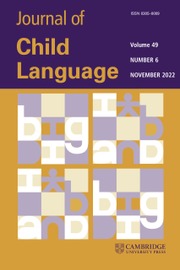Article contents
Early phonological and lexical development and otitis media: a diary study*
Published online by Cambridge University Press: 26 September 2008
Abstract
This diary study describes early phonological and lexical development in a child with chronic otitis media with effusion. Equipped with the tools of a referential/analytic language-learner, the child solved the problem of reduced and fluctuating auditory input with phonological selection and avoidance strategies that capitalized on prosodie cues. This ‘tone-language’ approach resulted in a lexical inventory that would be categorized as an extreme expressive style. Having ‘boot-strapped’ her lexical learning, the child continued to rely on phonological constraints and selection strategies to fuel lexical and syntactic growth, i.e. cross-domain interactions leading to a vocabulary spurt and the onset of two-word utterances. These findings illustrate the need to consider interactions among performance, input and linguistic constraints in order to explain individual variation in language learning.
- Type
- Articles
- Information
- Copyright
- Copyright © Cambridge University Press 1993
Footnotes
A version of this paper was presented at the American Speech/Language/Hearing Association Convention, Boston, 1988. The author wishes to thank Lise Menn for her invaluable comments.
References
REFERENCES
- 8
- Cited by


